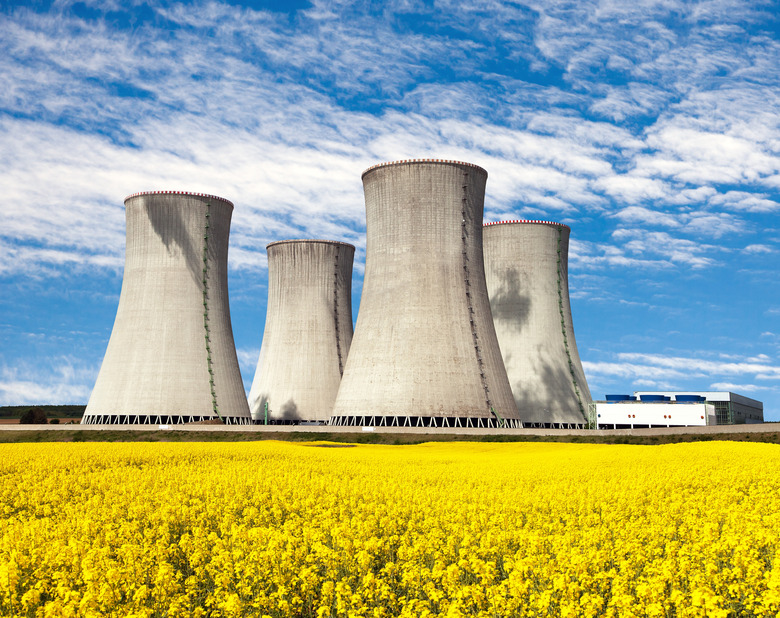Environmental Effects Of The Atomic Bomb
When an atomic or nuclear bomb detonates, the 1 megaton blast kills or poisons everything within a two-mile radius. The accident at the Chernobyl power plant in 1986 and the bombs dropped on Hiroshima and Nagasaki in 1945 provide insight into the short and long-term effects of radiation and thermonuclear detonation on the environment. If enough nuclear weapons were exploded in a large-scale nuclear war, vast areas of the earth would become uninhabitable.
TL;DR (Too Long; Didn't Read)
When an atomic or nuclear bomb detonates, the 1 megaton blast kills or poisons everything within a two-mile radius. The accident at the Chernobyl power plant in 1986 and the bombs dropped on Hiroshima and Nagasaki in 1945 provide insight into the short and long-term effects of radiation and thermonuclear detonation on the environment. Radioactive particles can travel from the site of an atomic bomb explosion and contaminate the land and water for miles. Genetic mutations and disease in the generations of plants, animals and humans following contamination also occurs. Contamination remains for decades.
Immediate Environmental Effects
Immediate Environmental Effects
When an atomic bomb explodes, plutonium in the device undergoes fission, releasing enormous quantities of energy. The initial blast creates a blinding flash, followed by temperatures in the area of the explosion reaching upwards of 10 million degrees Celsius. Electromagnetic radiation leads to the formation of a fireball. A crushing wind caused by the initial blast destroys buildings and trees in its path. A single 15 kiloton bomb detonated over the center of Hiroshima near the end of World War II, destroying everything within a 1-mile radius of the city. The effect on the immediate environment is one of total devastation. The extreme heat of thermal radiation burns everything in its path, including animals, trees, buildings and people. Many of those who did not die from radiation or burns later developed cancers from the radiation.
Explosive Fallout
Explosive Fallout
The detonation of an atomic bomb creates radioactive dust that falls out of the sky into the area around the site of the explosion. Wind and water currents carry the dust across a much larger radius than the initial explosion, where it contaminates the ground, water supply and the food chain. Initially, little was known about radioactive fallout. In the 1950s, scientists in the United States discovered from nuclear weapons testing that the particles in this dust were comprised of split atoms that were highly radioactive and dangerous. Radioactive particles from nuclear fallout also can contaminate both wild and domesticated animals, as well as agricultural plants.
Radiation Effects
Radiation Effects
The release of radiation from the Chernobyl power plant gives scientists an idea of what the effects would be on the environment in a small nuclear war. The amount of radiation released at Chernobyl is equivalent to the detonation of about a dozen atomic bombs at an altitude that would cause maximum blast damage. At Chernobyl, large amounts of radioactive particles called iodine-131 and cesium 137 were released into the environment during a fire that burned for 10 days. These isotopes are particularly dangerous to living organisms.
Water and Forest Contamination
Water and Forest Contamination
Radioactive particles can travel from the site of an atomic bomb explosion and contaminate bodies of water, including aquatic life like fish. In addition, the fallout from the detonation of numerous atomic bombs would result in the contamination of berries and other plant life found in the surrounding areas and forests. Genetic mutations and disease in the generations of animals and humans following contamination would also occur. Animals in Chernobyl's forests, for example, have high levels of radioactive cesium. Scientists expect the contamination to remain that way for decades.
Cite This Article
MLA
Lemon, Kylie. "Environmental Effects Of The Atomic Bomb" sciencing.com, https://www.sciencing.com/environmental-effects-atomic-bomb-8203814/. 16 April 2018.
APA
Lemon, Kylie. (2018, April 16). Environmental Effects Of The Atomic Bomb. sciencing.com. Retrieved from https://www.sciencing.com/environmental-effects-atomic-bomb-8203814/
Chicago
Lemon, Kylie. Environmental Effects Of The Atomic Bomb last modified August 30, 2022. https://www.sciencing.com/environmental-effects-atomic-bomb-8203814/
